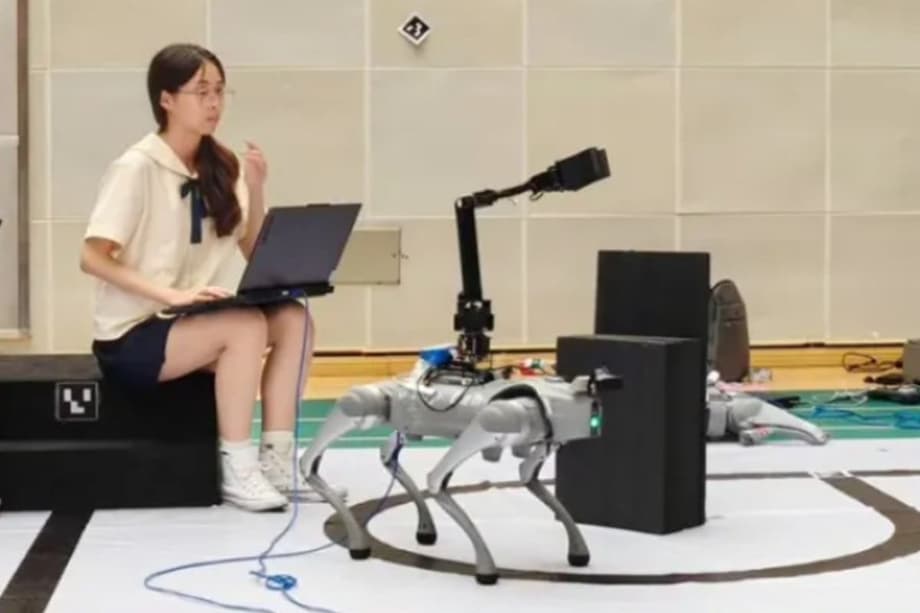Students get hands on with robot dogs
Unitree Robotics has launched a classroom ready training program centered on its Go2 robot dog, giving students a structured way to learn how quadrupeds work and what they can do. The company says the in person course brings ready to use tools, simulation and guided practice to schools and training centers. Students learn how to operate the Go2 safely, keep it in working order, and apply it to tasks that mirror real use. The hardware at the heart of the program, the Go2, is listed from 1,600 US dollars on Unitree’s site. It pairs a mobile app with an onboard sensor suite, including the company’s own 4D lidar for wide angle scanning. With a simple tap on the app, users can mark a spot on the map for the robot to reach on its own. The Go2 also ships with ISS 2.0, an intelligent side follow feature that lets the robot walk beside its owner, avoid obstacles and hold a stable position through busy spaces.
Education has become a key bridge between early adopters and everyday users. Lower price tags and quicker learning curves are bringing quadrupeds from labs and maker clubs to classrooms. In China, new training hubs and youth robotics centers point to a broader talent push. The consumer side is heating up too. Beijing startup Noetix recently announced a compact humanoid named Bumi for home and school use. Unitree itself has begun selling a smaller humanoid called R1 at a price that is far below its earlier G1 model. That mix of falling costs and rising interest has created a timely opening for a structured course built around a capable platform like the Go2.
According to Unitree, the course follows a graded pathway. Lessons begin in simulation, move to supervised practical sessions, and then step into team projects and friendly contests. Safety is highlighted throughout. Classroom kits and debugging stations accompany the sessions so students can test code, troubleshoot and fix small issues without putting the robot or bystanders at risk. Core topics cover daily upkeep, motion control, autonomous navigation and what the company calls secondary development, a track that shows students how to extend the robot’s functions with code and add ons. For colleges, technical schools and even advanced high school programs, the package aims to cut setup time and provide a unified structure that teachers can run with from day one.
What the Unitree program covers
The curriculum focuses on three pillars, operation, autonomy and extension. Operation includes startup and shutdown routines, safety checks, gait selection and route planning with the mobile app. Autonomy modules explain how the robot maps a room, detects obstacles and chooses a safe path. Extension shows how to write simple programs, connect with common tools such as ROS (Robot Operating System) and prepare for custom projects. The company says the course will be graded, which allows schools to place students at the right level and measure progress over time.
Operation and maintenance
Mechanical checks, firmware updates and simple repairs are the foundation of a long lived robot. Students learn how to inspect joints and feet, balance the robot before a session, swap batteries safely, and recover from a fall. Instructors also walk through app based controls, from basic stance and posture changes to preset tricks. By the end of this block, learners should be able to prepare a Go2 for class, handle routine care and record logs that help with troubleshooting.
Motion control and navigation
Motion control introduces walking gaits, turning strategies and terrain handling. The Go2 can crouch, climb small steps and handle uneven floors, but those abilities rely on sensor fusion and planning. Lessons show how 4D lidar feeds a live map and how the onboard controller pairs that with camera input to avoid obstacles. Students practice side follow using ISS 2.0 in hallways and outdoor paths, then script waypoints in the app so the robot reaches a target position on its own while keeping clear of people and furniture.
Secondary development and research skills
Secondary development is Unitree’s term for building on the base system with code and external tools. Schools can introduce Python or C++, either through the company SDK or with ROS. Example projects include custom behaviors triggered by voice, map based patrol routines, and small research studies in human robot interaction. Debugging stations and simulators reduce risk, so students can test algorithms before sending them to the real robot.
- Basic operation and safety routines
- Navigation, mapping and side follow
- App based control and waypoint missions
- Coding with SDKs and ROS
- Project work and competitions
Inside the Go2 robot dog
The Go2 sits in the middle of Unitree’s quadruped range. It is compact enough for classroom demonstrations, yet stable on many indoor and outdoor surfaces. The robot carries an array of sensors and ties them together with an app that lets students see what the machine sees. Through the app, users can select gaits, adjust speed, run presets and capture photos or video from the robot’s point of view.
What 4D lidar and ISS 2.0 do
Unitree describes its 4D lidar as an omnidirectional, ultra wide angle scanner. In simple terms, the sensor sweeps the surroundings and measures distance in many directions. The system adds time to those distance readings, which helps track motion and build a live map. That map feeds the controller, so the robot can spot obstacles and step around them. ISS 2.0, or intelligent side follow, uses those data and visual cues to keep the robot at your side. The feature is designed to match the user’s pace and direction, cutting down on sudden stops or bumps in crowded areas.
- Omnidirectional lidar for mapping and collision avoidance
- Side follow that maintains position near the user through ISS 2.0
- App controls with simulator and presets for quick practice
- Options for block style coding that lower the barrier for beginners
Third party educators already teach the Go2 app in detail. For example, one course walks through real time mapping, block style programming, voice commands and control of add ons such as a small arm. These extras give teachers more ways to tailor lessons for beginners and for advanced students who want deeper control.
Why robot dogs are moving into schools
Falling costs, better software and an engaged community are pushing quadrupeds into education. Students who once watched slick videos of robots balancing on beams can now work with compact machines that fit in a classroom. Shows and science festivals bring the technology to a wider audience. A recent demonstration at New Scientist Live featured a Go2 entertaining a child, a reminder that these platforms grab attention and make abstract tech feel approachable.
Universities are also exploring deeper uses. A research team backed by the Institute for Future Technologies, a partnership between New Jersey Institute of Technology and Ben Gurion University, is building a socially assistive model of the Go2 that adapts to the person it meets. The project blends wearable sensors with edge computing so the robot can respond to signals like comfort or pain, with potential benefits in therapy and elder care. More details are available from NJIT’s announcement at NJIT.
Cross discipline projects are appearing at smaller schools as well. Alvernia University, for example, uses a cyberdog in new cybersecurity classes, while engineering students design protective shells and mounts with 3D printing. That mix of software, hardware and design mirrors the blend of skills employers seek in robotics and automation.
Use cases students can explore
Once a class has the basics down, the Go2 becomes a testbed for a wide range of projects. The platform is steady enough to carry small cameras or sensors in controlled settings, fast enough to practice path planning, and open enough to accept student code. The best outcomes tend to come from projects that mirror real tasks instead of novelty stunts.
- Indoor mapping of a classroom or lab with safe zones and geofences
- Waypoint missions that simulate inspection rounds
- Side follow studies, measuring how well ISS 2.0 tracks a person through crowds
- Voice driven behaviors that trigger specific motions or routines
- Human robot interaction experiments that test approach distance, gestures and feedback
- Media projects that use the robot’s camera to capture low angle video
- Basic search tasks in a mock obstacle course, with clear safety boundaries
- Cybersecurity labs on securing robot to app communication and logging
Competitions can motivate teams to refine their code and practice reliable operation. Events that prioritize safe navigation, robust recovery from falls and clear human communication teach habits that carry into future jobs. The Unitree course says it blends simulation, practical work and contests, which gives teachers a framework to grade both technical outcomes and teamwork.
Safety, ethics and responsible use
Robots that move quickly around people require careful planning. Schools that use mobile robots often adopt simple practices like supervised operation, designated test areas, and an emergency stop within reach of the operator. The new course says safety is part of every stage, from simulation to live runs, which is essential for student confidence and for protecting equipment.
Privacy is another classroom topic. Cameras, microphones and wireless links are powerful tools, yet they also collect data. Instructors can set clear rules on where recording is allowed, how to store footage, and how to get consent when filming. Lessons can also cover responsible design choices, such as avoiding facial identification or storing only what a project truly needs.
The limits of current hardware provide good teaching moments. Students learn how runtime changes with speed and terrain, how heat affects performance, and why lighter attachments often work better than heavy ones. Reliable operation, not flashy moves, is the trait that separates a good project from a forgettable demo.
How Unitree’s course compares
Unitree’s package delivers a coherent track tied to specific hardware, which can save teachers time. There are also many ways to extend learning. Third party providers teach the Go2 app with detailed lessons on mapping, block style coding and voice control. Open source communities offer libraries and examples that connect the robot to ROS and popular frameworks. Clubs and makerspaces provide peer support and places to test new ideas.
Some prospective buyers still want more day to day accounts from owners. Forum posts show a steady stream of questions about noise, setup, software maturity and long term reliability. A school can address this by running small pilots before large purchases, by documenting lessons learned, and by letting students present real results. The most valuable skill the course can teach is not a single programming trick, it is how to diagnose problems and recover quickly when a test fails.
Market outlook and consumer appetite
China’s robotics sector is moving quickly toward affordable machines for education and home use. Noetix’s Bumi and Unitree’s R1 show how humanoids are edging toward the consumer space. Quadrupeds like the Go2 occupy a complementary niche, steady on rough surfaces and approachable for first time users. The launch of a graded, classroom ready course suggests Unitree is courting schools that want a consistent path from basics to advanced work.
If the program spreads, it could help standardize how students learn core robotics topics like mapping, state estimation and navigation. Schools gain a known platform with ready curriculum. Companies gain graduates who understand how to work with sensors, test safely and think in terms of systems. The strongest signal from this launch is that robot dogs are no longer just a lab spectacle. With a clear syllabus and a price within reach of many programs, they are turning into a practical teaching tool.
Key Points
- Unitree launched an in person student course built around the Go2 robot dog
- The program covers operation, maintenance, motion control, navigation and secondary development
- Go2 features include 4D lidar for wide angle scanning and ISS 2.0 side follow
- Lessons progress from simulation to supervised practice, team projects and competitions
- Third party courses teach Go2 app features like mapping and block style programming
- Universities use the Go2 in research, including socially assistive projects with wearable sensors
- Schools cite safety, privacy and reliability as central classroom topics for mobile robots
- Falling costs and rising interest are bringing quadruped robots into mainstream education




